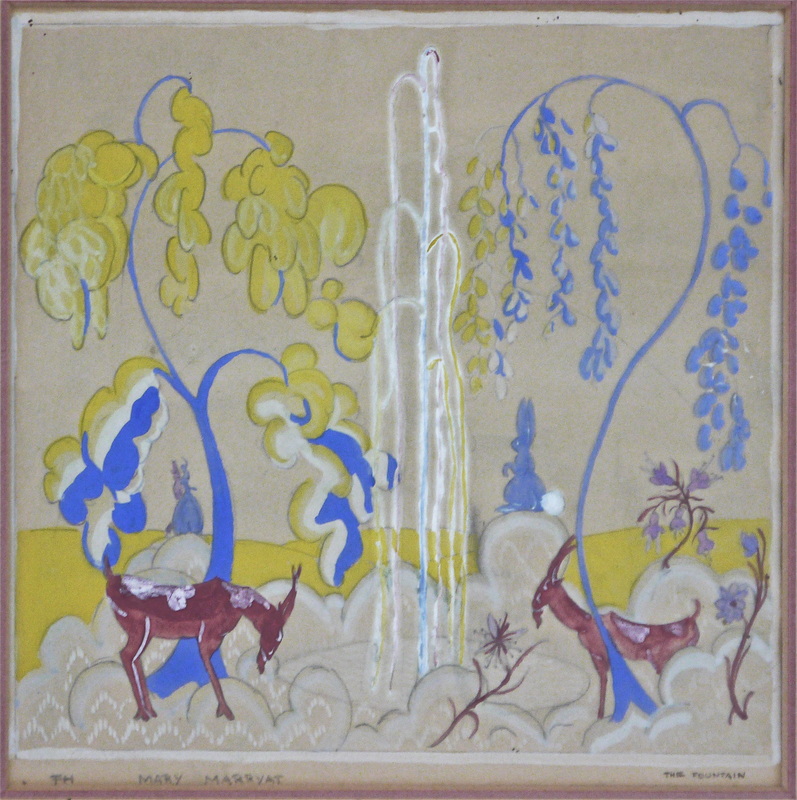Mary Kent Harrison was born in Richmond, London and lived in the family home there on The Terrace, overlooking the river Thames, until after the 2nd World War and marriage after which she moved to Cambridge with her husband George Kent Harrison and the first three of seven children. She was evidently very attached to Richmond and would often return there later with her own family, and she continued to make paintings of views of Richmond, especially of the river Thames there and Richmond Park, right up until the 1970's.
Mary Marryat - 1931 - School Photograph. (Twizzletwig School For Girls, Hindhead, Thursley, Surrey)

Mary with her fellow pupils at Twizzletwig School, 1931.

What a wonderful name for a school!
Twizzletwig was a private boarding school for girls in Hindhead probably opened during the First World War. It occupied premises on Tilford Road, Hindhead. With four teaching staff and the same number of domestic staff the school depended on visiting teachers for dancing, music, elocution and art lessons. The vicar of Hindhead took scripture classes. The description in the advert below may give an idea of what life was like at the school.
The above photo shows the names of her fellow pupils and it is likely that she kept in touch with some of them.
The school was still in existence in 1938.
Twizzletwig was a private boarding school for girls in Hindhead probably opened during the First World War. It occupied premises on Tilford Road, Hindhead. With four teaching staff and the same number of domestic staff the school depended on visiting teachers for dancing, music, elocution and art lessons. The vicar of Hindhead took scripture classes. The description in the advert below may give an idea of what life was like at the school.
The above photo shows the names of her fellow pupils and it is likely that she kept in touch with some of them.
The school was still in existence in 1938.

 A dormitory at the Twizzletwig School.
A dormitory at the Twizzletwig School.


The above two images are from an early mixed media work possibly done at school about the tragic disaster on The Thames in 1878 when The Princess Alice was sunk in a collision with the collier Bywell Castle, with the loss of 650 lives.
Drawing Book - 1928

This drawing book seems likely to have been created in the last year of her time at Twizzletwig School.
From the above sketchbook - 1928

The Swimming Baths - 1932

Design for a Christmas card - 1934

Mary made her own Christmas cards every year throughout her life. This early one was probably commissioned by her father and is signed M.Marryat.

Mary's Lamb

A charming six page booklet, signed Mary Marryat, 11th March 1934, and possibly done in the early years at Art School partly as an exercise in calligraphy, a skill which would have been on the curriculum at that time, and one in which MKH became very proficient. The highly styled figure drawing already evident here would be a characteristic in later artistic development.
Towel - 1935
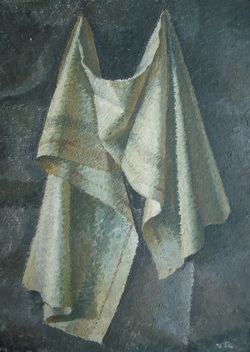
Noted in the record book as 'First Oil Painting'
1935 - signed Mary Marryat

This classic Art School exercise, the depiction of simple forms, would have been carefully scrutinized by her tutors. Pre-Art School, and early Art School work reveals that drawing and painting did not come naturally to her. They were learned through pure hard work and determination within the disciplined environment of the 1930's Art College. The language she learned there enabled her to later express her visual ideas fluently without an indulgence in, or need for the 'fortuitous accidents of paint' or the 'nice mark' so much revered in Art Schools as the century progressed - not that there is anything wrong with that. In her case, the work was not 'about paint'. Paint and other materials were never applied as an end in themselves, they were a means to an end. Having said that, it is also the case then when one looks at her paintings close up, it is very rewarding, because of the richness of the oil paint used and the actual surface of the paintings. The paint is applied quite generously, often with a palette knife, and the colours resonate with great depth. Seen now as a great strength, and part of the character and individuality of her work, it was, at the time she was active, a relatively lonely path for her to walk and this 'old fashioned' approach would have alienated many. She said once that she 'never got Cezanne', and it seems that the Art Movements during the 20th century starting perhaps with Abstract Expressionism were of little interest to her and very little influence on her output. Her work is relatively devoid of the inescapable irony, humourous twists and the self referential intellectualism that followed on from Marcel Duchamp - and is none the worse for it. Despite all this her work, within her own private art movement, almost always found a home, at the R.B.A., the N.E.A.C. (she exhibited regularly at both establishments), other London galleries such as The Leicester Galleries, and galleries throughout the United Kingdom. Her work sold. She was able to let go of it, for the benefit and pleasure of others. Fortunate indeed are those who found her work irresistible and supported her by making a purchase.
Anatomy diagram - 1935

One of many extraordinarily detailed anatomy drawings from a folio dated 1935 and done at Art School. This one is made from a drawing on paper of the skeleton and then a further drawing of muscle tissue made on a separate transparent tracing paper type of material which is laid, but not attached, over the top. This diagram is titled 'Skeleton From The Side' and signed Marryat top left. All bone and muscle material are clearly labelled.
One imagines if she later discussed the knowledge gained by such work with her future husband, G. Kent Harrison, a surgeon, and how it would have compared in detail with his training in medicine. Her liking of the Renaissance artists would have reminded her that at that time (the early Renaissance) the roles of artists and scientists were closely related, particularly in the the fields of physiology and physics.
One imagines if she later discussed the knowledge gained by such work with her future husband, G. Kent Harrison, a surgeon, and how it would have compared in detail with his training in medicine. Her liking of the Renaissance artists would have reminded her that at that time (the early Renaissance) the roles of artists and scientists were closely related, particularly in the the fields of physiology and physics.
Anatomy diagram - 1935

Another drawing from the same folio. This one concerning muscles of the forearm.
In the 1930's anatomy studies at Art School would have been regarded as extremely important in the training of an Artist. It was regarded as essential for the convincing portrayal of the human form in two or three dimensions.
It looks like the anatomical training was very thorough and the knowledge well taught.
In the 1930's anatomy studies at Art School would have been regarded as extremely important in the training of an Artist. It was regarded as essential for the convincing portrayal of the human form in two or three dimensions.
It looks like the anatomical training was very thorough and the knowledge well taught.
Rain - 1934

Studies in perspective - 1935

Studies in perspective (detail from a larger drawing) - 1935


A design possibly for textile printing.

Above is a certificate from The Slade School Of Fine Arts, for the session dated 1936/1937 in testimony of Mary's achievement in the subject of Drawing. Signed by Randolfe Schwabe, Slade Professor.
Her training as an artist commenced at Kingston-On-Thames School of Art 1934 to 1935 where she gained a Board Of Education Diploma in Drawing And painting. She then attended The Slade School, London, during 1935 to 1937 where, in 1936 she won The Slade Prize. Finally, she attended The Royal Academy from 1937-1939. One of her teachers at the Royal College Of Art was Vivian Pitchforth, R.A. 1895-1982, and it is possible to detect echoes of his work in some of MKH's landscapes. Vivian Pitchforth also painted in Yorkshire where MKH painted later in her life. Stanley Spencer is often mentioned as being similar in some of his work. It is possible to see some slight similarity in the depiction of the human figure in MKH's early work, but there is at present no first hand evidence that MKH particularly admired his work. Their depiction of landscape seems very different, and Spencer's figurative compositions are based far more in the imagination, whereas in very nearly all examples, MKH painted what she saw - even if, for the purposes of painting, it was what she chose to see.
In her studio, books on Art were weighted in favour of the Old Masters. Michelangelo, Durer, Rembrandt, Titian, Rodin, Velasquez. It was perhaps the Old Masters who were her biggest influence. From them, and her teachers at Art School she learnt as much as she could about how to compose her paintings and create the illusion of form and space. Scrapbooks in her studio also revealed an interest in Degas, Augustus John, Turner and John Constable.
Her training as an artist commenced at Kingston-On-Thames School of Art 1934 to 1935 where she gained a Board Of Education Diploma in Drawing And painting. She then attended The Slade School, London, during 1935 to 1937 where, in 1936 she won The Slade Prize. Finally, she attended The Royal Academy from 1937-1939. One of her teachers at the Royal College Of Art was Vivian Pitchforth, R.A. 1895-1982, and it is possible to detect echoes of his work in some of MKH's landscapes. Vivian Pitchforth also painted in Yorkshire where MKH painted later in her life. Stanley Spencer is often mentioned as being similar in some of his work. It is possible to see some slight similarity in the depiction of the human figure in MKH's early work, but there is at present no first hand evidence that MKH particularly admired his work. Their depiction of landscape seems very different, and Spencer's figurative compositions are based far more in the imagination, whereas in very nearly all examples, MKH painted what she saw - even if, for the purposes of painting, it was what she chose to see.
In her studio, books on Art were weighted in favour of the Old Masters. Michelangelo, Durer, Rembrandt, Titian, Rodin, Velasquez. It was perhaps the Old Masters who were her biggest influence. From them, and her teachers at Art School she learnt as much as she could about how to compose her paintings and create the illusion of form and space. Scrapbooks in her studio also revealed an interest in Degas, Augustus John, Turner and John Constable.
Study for a painting
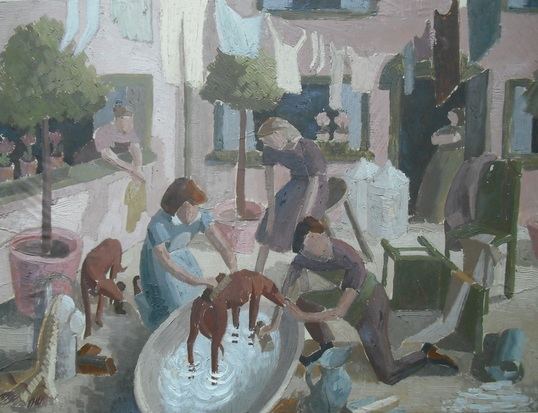
Study for a painting
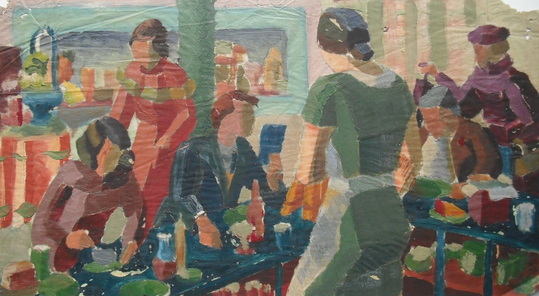
Study for a painting

Work for The Army Blood Transfusion Service

Signed and dated 14th September 1939, thirteen days after the outbreak of the Second World War. This may have been a commission presumably for posters, or a project within Art School.
Throughout her career, MKH practiced in the field of Graphic Art, as well as her better known work in Fine Art. This is an early example showing her ability to work to a brief and communicate the necessary with convincing, contemporary style. It also is evidence of her work in the War Effort. During the war, one of the places she worked at was the Ordinance Survey in Bath, specializing on map production.
This piece is a good example of how, through the exploration of her Art, a fascinating glimpse will often be seen of the history of the 20th Century.
Throughout her career, MKH practiced in the field of Graphic Art, as well as her better known work in Fine Art. This is an early example showing her ability to work to a brief and communicate the necessary with convincing, contemporary style. It also is evidence of her work in the War Effort. During the war, one of the places she worked at was the Ordinance Survey in Bath, specializing on map production.
This piece is a good example of how, through the exploration of her Art, a fascinating glimpse will often be seen of the history of the 20th Century.
Mary Kent Harrison in The Sculpture Studio at Grays School Of Art. Aberdeeen, 1941

Mary Kent Harrison in the sculpture studios at Grays School Of Art, Aberdeen, in 1940.
This very atmospheric photograph has been confirmed as having been taken at Grays School Of Art, Aberdeen. The abundance of classic casts of Greek and Roman sculpture would appear to have been a great help and inspiration. Her husband, Kent was stationed in Aberdeen Royal Infirmary during 1940/41 where he held the post of Surgical Registrar. It is possible that MKH attended courses of some kind at Grays School Of Art during that year.
Mrs Edmunds Mother, preparatory sketch for an oil painting - 1930's

Design/drawing for a Christmas card 1936.
.
.
Possibly a preparatory sketch for 'Janie' 1936

The seriousness and introspection of this moment are deeply felt.
Title and date unknown
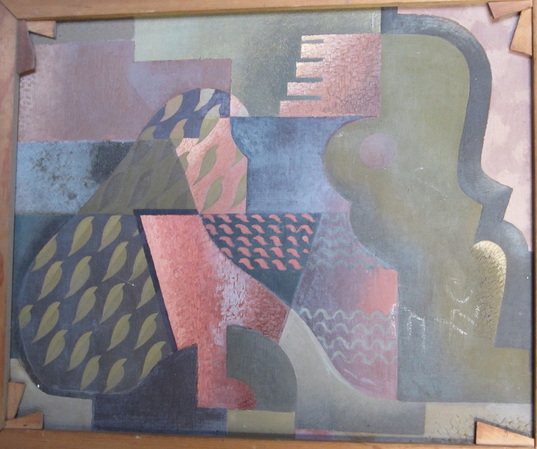
This is the only known 'abstract' or semi abstract painting by MKH. Possibly done at Art School as an instructed project, the painting is interesting and likeable in its own way. It was discovered on the back of one of her early oil paintings. It seems to involve the deliberate use of warm and cool colours, which is something very characteristic of her work.
